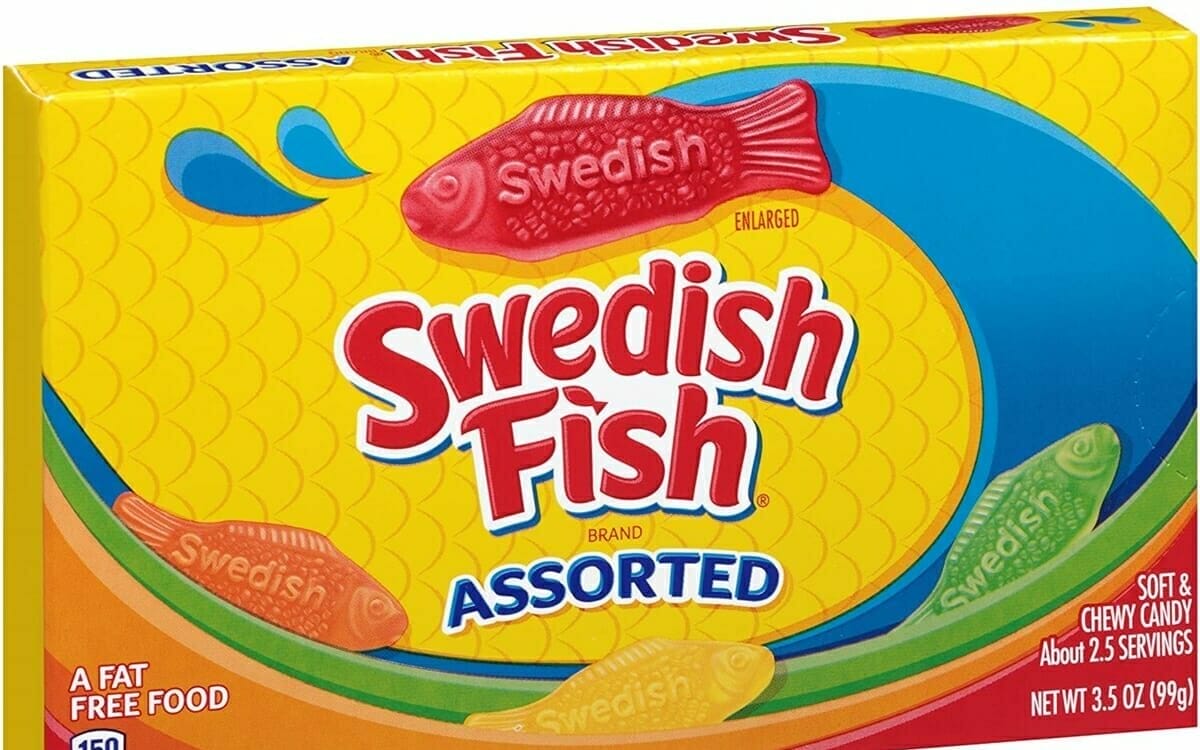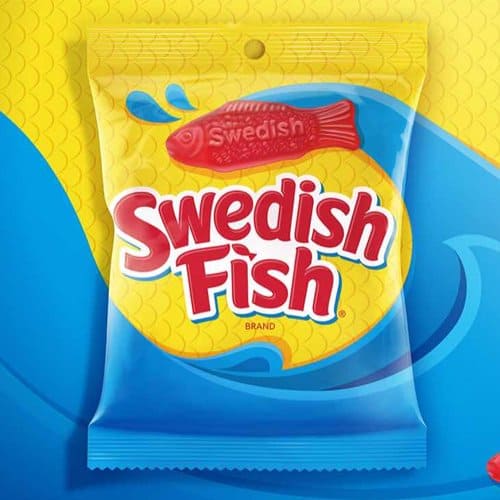Why Swedish Fish might not be vegan for you depends on how strict of a vegan you are and how you define veganism. Some of the ingredients in these gummies, like sugar and palm oil, might seem vegan at first glance, but they might not be vegan after all.
To answer your question, “Is Swedish Fish vegan?” once and for all, we’ll tell you what comes into Swedish Fish.
For many vegans and vegetarians, Swedish Fish candies seem like a convenient gas station snack choice. But are these chewy, colorful treats actually vegan? The answer isn’t so straightforward. While Swedish Fish don’t contain any obvious animal products like gelatin, some ingredients and production methods raise questions.
In this article, we’ll take a close look at what’s really in Swedish Fish, examining the potential issues from a vegan perspective. We’ll also overview different opinions on controversial ingredients like sugar and palm oil. Our goal is to provide the information you need to make an informed decision about whether these nostalgic candies align with your own vegan diet and ethics.
A Brief History of Swedish Fish
First, a quick history about how Swedish Fish came to be. The candy was created in the late 1950s by Swedish company Malaco as a unique take on gummy fish They were originally named “Malaco Seafood Bites” and came in just one color – red
The candy was marketed specifically to the United States, with the name soon changing to “Swedish Fish” along with new fruity flavor varieties. Today Swedish Fish production is handled by American snack giant Mondelez International. The candy remains a top-selling gummy brand now available in different colors and flavors.
The Ingredients Rundown – What’s in Swedish Fish?
Swedish Fish have a short and sweet ingredient list. According to the manufacturer the candies contain
- Sugar
- Corn syrup
- Modified corn starch
- White mineral oil
- Natural and artificial flavors
- FD&C Red 40 coloring
- Carnauba wax coating
So what’s potentially problematic about these ingredients for vegans? Let’s break it down.
The Sugar Factor
Sugar is the number one ingredient. There’s been much debate around whether sugar itself can be considered vegan. The concern stems from how most mass-produced white sugar is processed. It’s often filtered through bone char – charcoal made from animal bones – to achieve its coloration.
Many strict vegans avoid conventional white sugar for this reason. However, since bone char is only used in processing, it’s not present in the finished sugar. Other vegans may avoid it only if bone char is specifically indicated on the label or look for organic sugar that doesn’t undergo this process.
Artificial Colors
Red 40 dye gives Swedish Fish their signature color. While artificial colors themselves are vegan, as they aren’t animal-derived, there are other factors at play. Synthetic food dyes typically undergo animal testing during development and approval stages. This is a deal-breaker for vegans who boycott any items tested on animals.
Natural and Artificial Flavors
These undefined flavorings also give rise to concerns. Manufacturers don’t have to disclose what exactly they are. “Natural flavors” could potentially contain ingredients like fish or meat extracts, eggs, or dairy that would make them non-vegan. Vegan consumers have to trust that the company uses vegan-friendly natural flavorings.
Palm Oil
Some Swedish Fish varieties use palm oil to replace beeswax as a coating. While palm oil itself is plant-based, large-scale palm oil production has led to deforestation and destruction of wildlife habitats. Avoiding palm oil for this reason is a personal choice based on environmental ethics.
The Beeswax Controversy
Here’s where we get into one of the biggest gray areas for vegans – beeswax. Some packages of Swedish Fish list beeswax as their shiny outer coating instead of palm oil or carnauba wax.
Beeswax alone doesn’t contain animal products. It’s made from bees’ honeycomb. But many vegans still don’t consider it 100% vegan because harvesting beeswax can be seen as exploitative beekeeping practice.
The ethics around avoiding beeswax come down to a personal decision. There are good-faith arguments on both sides within the vegan community. Some vegans abstain from it entirely, while others may consume it in moderation from ethical beekeeping operations.
Checking Labels is Crucial
As we’ve seen, Swedish Fish ingredients can vary by package. Some use beeswax while others use vegan wax alternatives. Some contain palm oil while others don’t. So checking the ingredient label on each individual package is key for vegans.
Online stores like Amazon also don’t always accurately list ingredients for Swedish Fish, making in-person label reading vital. Don’t assume all packs of Swedish Fish candies will be vegan without verifying first.
Where Individual Vegans Stand
Given all the points raised, individual vegans make their own personal decisions on whether to consider Swedish Fish off-limits.
More strict vegans will avoid them entirely based on concerns around bone-char filtered sugar, artificial colors tested on animals, and any potential for non-vegan natural flavors or hidden animal-derived ingredients like beeswax.
Less strict vegans may look for Swedish Fish made without beeswax and eat them in moderation. They may be less concerned about sugar processing methods.
There are good-faith rationale on both ends of the spectrum. No single viewpoint represents all vegans. As with many gray area products, it’s about making the choice that you feel best about.
Alternatives for Vegans Avoiding Swedish Fish
Luckily, there are plenty of alternative vegan candies if you decide to give Swedish Fish a pass. Here are a few great options:
- YumEarth Organic Fruit Snacks
- Surf Sweets Organic Fruity Bears
- Annie’s Organic Bunny Fruit Snacks
- Trader Joe’s Scandinavian Swimmers
- SmartSweets Sweet Fish
These contain no beeswax, bone-char sugar, or artificial colors. They’re made with only vegan ingredients and many are organic as well.
You can also make homemade Swedish Fish copycats using vegan jello, natural colors from beets or spinach, and agar agar powder to set them. Then coat them in carnauba wax.
The Verdict: Let Your Ethics Guide You
When it comes to Swedish Fish, personal vegan ethics play a big role. There are valid points on both sides of the debate around certain grey area ingredients. Every vegan ultimately has the right to decide where their own boundaries lie.
Hopefully this look behind the scenes at what goes into Swedish Fish provides helpful insight to inform your own decision-making process. If in doubt, opt for one of the many alternative vegan gummy candies out there!

What is Swedish Fish?
Swedish Fish are fish-shaped candies with a chewy texture and the word Swedish across the fish body. Before, they were only available in one color, red. Now, they come in more bright colors, like yellow, orange, and green.
Some people thought this was a cherry-flavored snack, but the original flavor of red Swedish Fish is lingonberry, which is a berry that only grows in Europe. Other popular food flavors have also been added, such as orange and lemon-lime. There had been a grape-flavored fish in the color purple, but this was discontinued by 2006.
A Swedish candy company called Malaco made this chewy candy in the late 1950s to sell in the United States.

Chipotle was one of the first fast-casual restaurants in the US. By 2020, they will have over 2,500 locations around the world, in places like Canada, France, Germany, and the UK.
Swedish Fish Basic Ingredients

Are Swedish Fish Vegan? Untangling the Sweet Mystery
Are Swedish Fish bad for You?
Swedish Fish contains high-carb sweeteners like sugar and high fructose corn syrup. These sweeteners will cause your blood sugar level to spike and prevent you from reaching ketosis. As an alternative, you may look for other gummies that use keto-friendly sweeteners like stevia, monk fruit, or erythritol.
Can vegetarians eat Swedish Fish?
Yes, the Assorted Swedish Fish are vegan. Both the regular packaged and the peg bag Assorted Swedish Fish are fully vegan-friendly. The ingredient list of the Assorted Swedish Fish on the website of Mondelēz is totally vegan-friendly. The ingredients which are used in the making of Swedish Fish are quite the same for these candies too.
How many carbs in Swedish Fish?
Swedish Fish – Swedish Fish Small. Serving Size : 20 fish. 150 Cal. 100% 38g Carbs. 0% — Fat. 0% — Protein.
Do Swedish Fish have gluten?
While they’re not labeled gluten-free – Swedish Fish contain no gluten ingredients. However, if you only eat items that contain “gluten-free” on the label, you probably want to avoid Swedish Fish. Mondelez International points out that they take extra precautions to make sure their products are safe and properly labeled.
